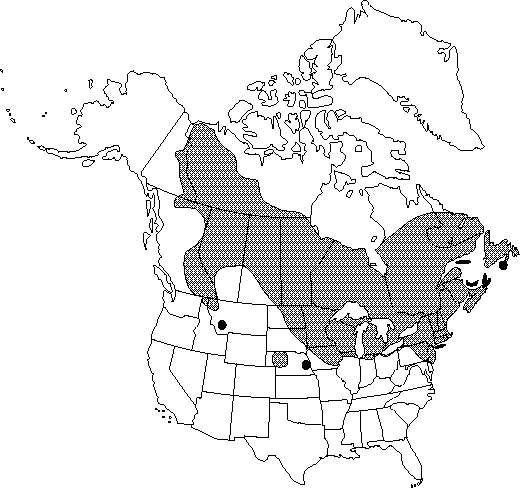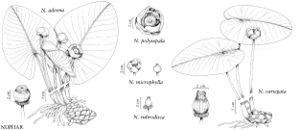Nuphar variegata
in G. W. Clinton, Rep. (Annual) Regents Univ. State New York State Cab. Nat. Hist. 19: 73. 1866 (as variegatum).
Rhizomes 2.5-7 cm diam. Leaves mostly floating, occasionally submersed; petiole adaxially flattened, with median ridge, winged along margins. Leaf blade abaxially and adaxially green, sometimes abaxially purple-tinged, broadly ovate to oblong, 7-35 5-25 cm, 1.2-1.6 times as long as wide, sinus 1/3-1/2 length of midrib, lobes approximate to overlapping; surfaces glabrous. Flowers 2.5-5 cm diam.; sepals mostly 6, abaxially green to yellow, adaxially usually with red or maroon toward base; petals oblong, thick; anthers 3-9 mm, longer than filaments. Fruit mostly purple-tinged, ovoid, 2-4.3 2-3.5 cm, strongly ribbed, slightly constricted below stigmatic disk; stigmatic disk green, rarely reddened, 8-20 mm diam., entire to deeply crenate; stigmatic rays 7-28, linear to narrowly lanceolate, terminating 0-1(-1.5) mm from margin of disk. Seeds 2.5-5 mm. 2n = 34.
Phenology: Flowering late spring–summer.
Habitat: Ponds, lakes, sluggish streams, and ditches
Elevation: 0-2000 m
Distribution

St. Pierre and Miquelon, Alta., B.C., Man., N.B., Nfld., N.W.T., N.S., Ont., P.E.I., Que., Sask., Yukon, Conn., Del., Idaho, Ill., Ind., Iowa, Maine, Md., Mass., Mich., Minn., Mont., Nebr., N.H., N.J., N.Y., N.Dak., Ohio, Pa., R.I., S.Dak., Vt., Wis.
Discussion
Nuphar variegata is distinct throughout most of its range. The leaves are characteristically floating, being emergent only under low-water conditions. Intermediates between N. variegata and N. microphylla, probably of hybrid origin, are treated as N. rubrodisca. Some intergrading of characteristics occurs where the range overlaps with N. advena (E. O. Beal 1956). This can be observed in the mid-Atlantic region. Intermediates between N. variegata and N. polysepala occur in eastern British Columbia where the two species are sympatric. Authorship and typification of this name were discussed by E. G. Voss (1965).
Selected References
None.
